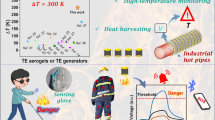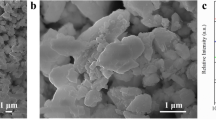Abstract
Octahydro-1,3,5,7-tetranitro-1,3,5,7-tetrazocine (HMX) is a typical highly energetic material that has been widely used in national defense industries since the 1940s. The aim of this study was to establish a reaction kinetic model on thermal decomposition properties via differential scanning calorimetry (DSC) by well-known kinetic equations and kinetic model simulation. Furthermore, the aim also was to compare kinetic algorithms for thermal decomposition energy parameters under various conditions. Experimental results highly depended on the reliability of the kinetic concept applied, which is essentially defined by the proper choice of a mathematical model of a reaction. In addition, the correctness of the methods is used for kinetics evaluation.







Similar content being viewed by others
Abbreviations
- A :
-
Pre-exponential factor (s−1)
- E a :
-
Activation energy (kJ mol−1)
- E αi :
-
Activation energy at isoconversional degree α i (kJ mol−1), i = 1, 2, 3, 4
- f(α):
-
Kinetic functions
- K :
-
Heat conduction coefficient (W m−1 K−1)
- Q :
-
Total heat of reaction (kJ kg−1)
- R :
-
Gas constant, 8.31415 (J K−1 mol−1)
- T 0 :
-
Exothermic onset temperature (°C)
- T f :
-
Final temperature (°C)
- T P :
-
Peak temperature (°C)
- T Pi :
-
Peak temperature of different scanning rates (°C), i = 1, 2, 3, 4
- T αi :
-
Different temperature in various scanning rates at isoconversional degree α i , i = 1, 2, 3, 4
- Α :
-
Degree of conversion, dimensionless
- β i :
-
Scanning rate (°C min−1), i = 1, 2, 3, 4
- ΔΗ d :
-
Heat of decomposition (kJ kg−1)
- E 1 :
-
Activation energy of 1st stage (kJ mol−1)
- E 2 :
-
Activation energy of 2nd stage (kJ mol−1)
- E a :
-
Activation energy (kJ mol−1)
- f i :
-
Kinetic functions of ith stage, i = 1, 2, 3
- k 0 :
-
Pre-exponential factor (m3 mol−1 s−1)
- k i :
-
Rate constant of ith stage (mol L−1 s−1), i = 1, 2, 3
- n i :
-
Reaction order of ith stage, dimensionless, i = 1, 2, 3
- Q 0 :
-
Heat production (kJ kg−1)
- Q t :
-
Heat production rate (kJ kg−1 min−1)
- r i :
-
Reaction rate of ith stage (g s−1), i = 1, 2, 3, 4
- T :
-
Absolute temperature (K)
- T :
-
Time (s)
- Z :
-
Autocatalytic constant, dimensionless
- Α :
-
Degree of conversion, dimensionless
- α i :
-
Reaction order of ith stage, dimensionless; i = 1, 2, 3, 4
- γ :
-
Degree of conversion, dimensionless
References
STARe Software with Solaris Operating System. Operating Instructions. Mettler Toledo. Sweden, 2004.
Kissinger HE. Reaction kinetics in differential thermal analysis. Anal Chem. 1957;29:1702–6.
Augis JA, Bennett JE. Calculation of the Avrami parameters for heterogeneous solid-state reactions using a modification of the Kissinger method. J Therm Anal. 1978;13:283–92.
Ozawa T. A new method of analyzing thermogravimetric data. Bull Chem Soc J. 1965;38:1881–6.
Ozawa T. Kinetic analysis of derivative curves in thermal analysis. J Therm Anal. 1970;2:301–24.
Ozawa T. Estimation of activation energy by isoconversion methods. Thermochim Acta. 1992;203:159–65.
Ozawa T. Thermal analysis-review and prospect. Thermochim Acta. 1999;355:35–42.
Flynn JH, Wall LA. A quick, direct method for the determination of activation energy from thermogravimetric data. J Polym Sci Part B. 1966;4(5):323–8.
Kossoy AA, Akhmetshin YG. Identification of kinetic models for the assessment of reaction hazards. Process Saf Prog. 2007;26(3):209–20.
Kossoy AA, Benin AI, Akhmetshin YG. An advanced approach to reactivity rating. J Hazard Mater. 2005;118(1–3):9–17.
Thermal Safety Software (TSS). ChemInform Saint-Petersburg (CISP) Ltd., St. Petersburg, Russia, http://www.cisp.spb.ru
Vyazovkin S, Wight CA. Model-free and model-fitting approaches to kinetic analysis of isothermal and nonisothermal data. Thermochim Acta. 1999;340–341:53–68.
Lee JS, Hsu CK, Chang CL. A study on the thermal decomposition behaviors of PETN, RDX, HNS and HMX. Thermochim Acta. 2002;392–393:173–6.
Singh G, Felix SP, Soni P. Studies on energetic compounds part 28: thermolysis of HMX and its plastic bonded explosives containing Estane. Thermochim Acta. 2003;399:153–65.
Chovancová M, Zeman S. Study of initiation reactivity of some plastic explosives by vacuum stability test and non-isothermal differential thermal analysis. Thermochim Acta. 2007;460:67–76.
Brown ME, Maciejewski M, Vyazovkin S, Nomen R, Sempere J, Burnham A, et al. Computational aspects of kinetic analysis part A: the ICTAC kinetics project-data, methods and results. Thermochim Acta. 2000;355:125–43.
Sewry JD, Brown ME. Model-free kinetic analysis? Thermochim Acta. 2002;390:217–25.
Tanaka H, Brown ME. The theory and practice of thermoanalytical kinetic of solid-state reactions. J Therm Anal Calorim. 2005;80:795–7.
Roduit B, Borgeat C, Berger B, Folly P, Andres H, Schädeli U, et al. Up-scaling of DSC data of high energetic materials simulation of cook-off experiments. J Therm Anal Calorim. 2006;85:195–202.
Lin CP, Shu CM. A comparison of thermal decomposition energy and nitrogen content of nitrocellulose in non-fat process of linters by DSC and EA. J Therm Anal Calorim. 2008;95:547–52.
Käser F, Bohn MA. Decomposition in HTPB bonded HMX followed by heat generation rate and chemiluminescence. J Therm Anal Calorim. 2009;96:687–95.
Acknowledgements
The authors are indebted to Dr. Yao-Hsun Hung, Dr. Tzu-Wan Ho, and Dr. Chang-Ping Chang for technical suggestions on experiments and analyses of HMX thermal properties. In addition, the authors are grateful to National Defense University of ROC in Taiwan.
Author information
Authors and Affiliations
Corresponding author
Rights and permissions
About this article
Cite this article
Lin, CP., Chang, YM., Tseng, JM. et al. Comparisons of nth-order kinetic algorithms and kinetic model simulation on HMX by DSC tests. J Therm Anal Calorim 100, 607–614 (2010). https://doi.org/10.1007/s10973-009-0592-4
Received:
Accepted:
Published:
Issue Date:
DOI: https://doi.org/10.1007/s10973-009-0592-4




